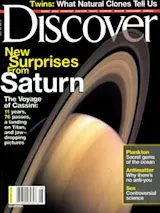In 1610 Galileo pointed his crude spyglass at Saturn and was dumbfounded by what he saw: “The planet Saturn is not alone, but is composed of three, which almost touch one another and never move nor change with respect to one another.” Worse, the two bulging planets on each side of the main planet had disappeared when he looked again a few months later. “What is to be said concerning such a strange metamorphosis?” he cried. Eventually, the frustrated Galileo decided never to look at Saturn again.
Now, of course, we have much better telescopes, and we know that Galileo was looking at the planet’s unique set of wide, thin rings. Seen broadside, they resembled companion planets through Galileo’s weak lenses; later, seen edge on, they shrank to nothingness—an invisible sliver. But nearly 400 years after Galileo’s observations, Saturn still teases astronomers, and the closer we look, the more oddities ...














